2.3.3: Ecology of Fungi
- Page ID
- 31936
Learning Objectives
- Describe some of the roles of fungi in ecosystems.
- Describe mutualistic relationships of fungi with plant roots and photosynthetic organisms.
- Describe the beneficial relationship between some fungi and insects.
Fungi play a crucial role in the maintenance of ecosystems. They are found in most habitats on Earth, though they are largely moisture-dependent. Their ability to exist in such a wide variety of habitats is often facilitated by symbiotic relationships with other organisms, whether these are parasitic, mutualistic, or commensal. Fungi are not obvious in the way large animals or tall trees appear, in part because they live within their food, digesting it externally before absorbing it. Like bacteria, they are the major recyclers of organic matter.
Habitats
Although fungi are primarily associated with humid and cool environments that provide a supply of organic matter, they colonize a surprising diversity of habitats, from seawater to human skin and mucous membranes. Fungi have been found living inside rocks and rocky substrates in marine ecosystems1, high in the Andes mountains on salt crusts2, in the hot springs of the Jurassic period3, and inside just about any organism you can think of. Chytrids are found primarily in aquatic environments. Other fungi, such as Coccidioides immitis, which causes pneumonia when its spores are inhaled, thrive in the dry and sandy soil of the southwestern United States. Fungi that parasitize coral reefs live in the ocean. However, most members of the kingdom Fungi grow on the forest floor, where the damp environment is rich in decaying debris from plants and animals. In these environments, fungi play a major role as decomposers and mutualists, facilitating the transfer of nutrients to members of the other kingdoms.
Decomposers and Recyclers
The food web would be incomplete without organisms that decompose organic matter (Figure \(\PageIndex{1}\)). Some elements—such as nitrogen and phosphorus—are required in large quantities by biological systems, and yet are not abundant in the environment. The action of fungi releases these elements from decaying matter, making them available to other living organisms. Trace elements present in low amounts in many habitats are essential for growth, and would remain tied up in rotting organic matter if fungi and bacteria did not return them to the environment via their metabolic activity.
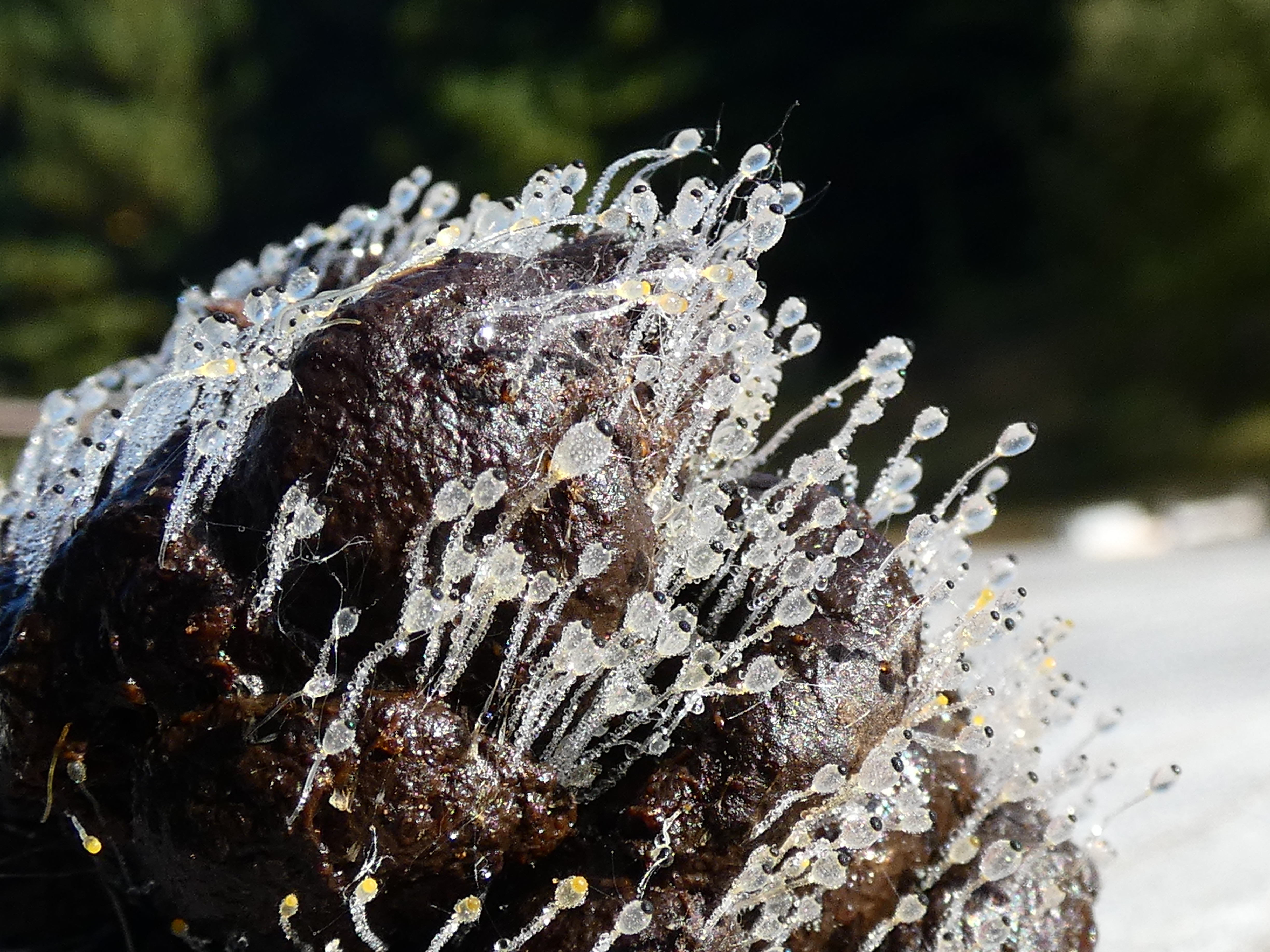
The ability of fungi to degrade many large and insoluble molecules is due to their mode of nutrition. As seen earlier, digestion precedes ingestion. Fungi produce a variety of exoenzymes to digest nutrients. The enzymes are either released into the substrate or remain bound to the outside of the fungal cell wall. Large molecules are broken down into small molecules, which are transported into the cell by a system of protein carriers embedded in the cell membrane. Because the movement of small molecules and enzymes is dependent on the presence of water, active growth depends on a relatively high percentage of moisture in the environment.
As saprotrophs, fungi help maintain a sustainable ecosystem for the animals and plants that share the same habitat. In addition to replenishing the environment with nutrients, fungi interact directly with other organisms in beneficial, and sometimes damaging, ways (Figure \(\PageIndex{2}\)).
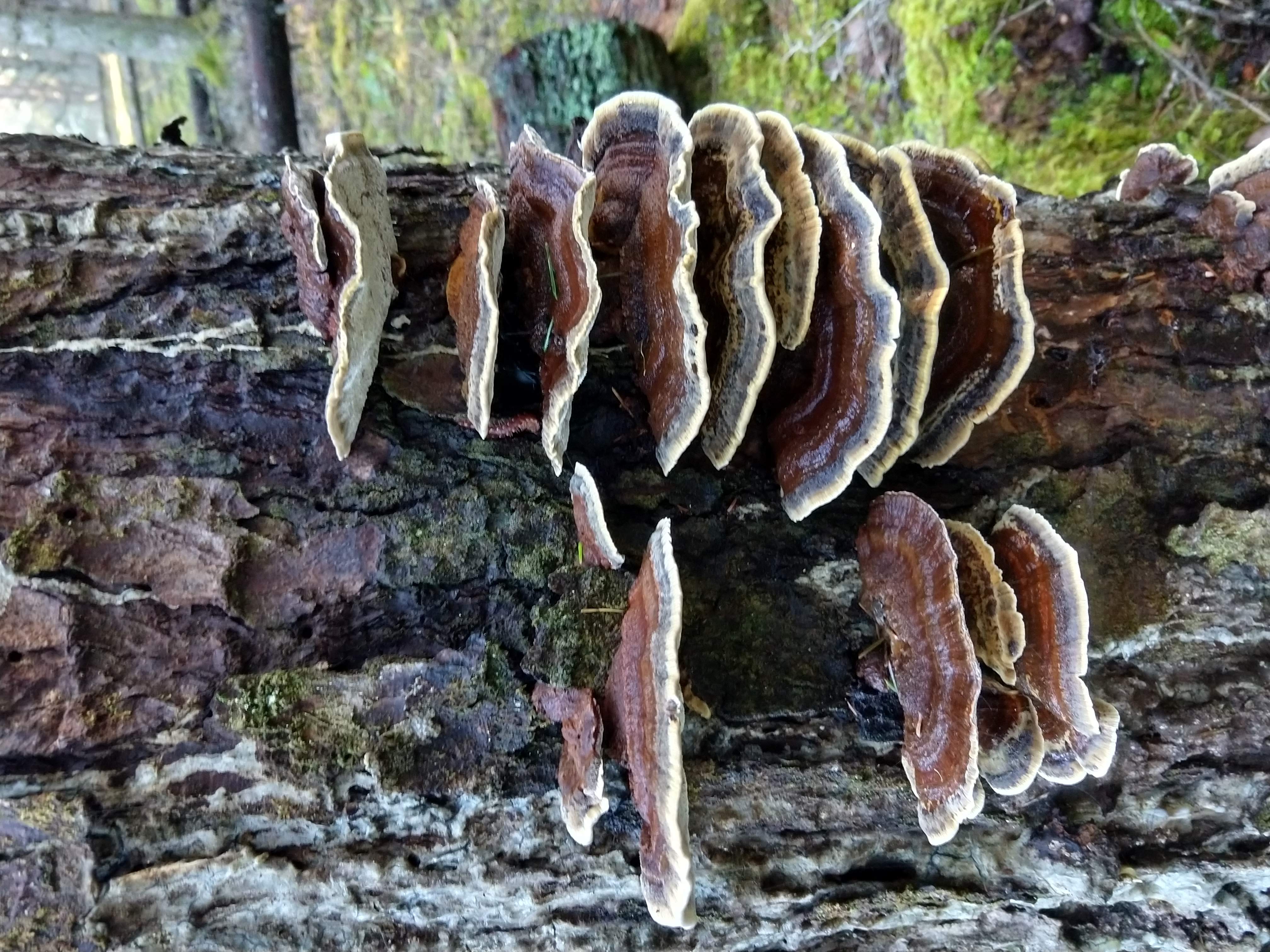

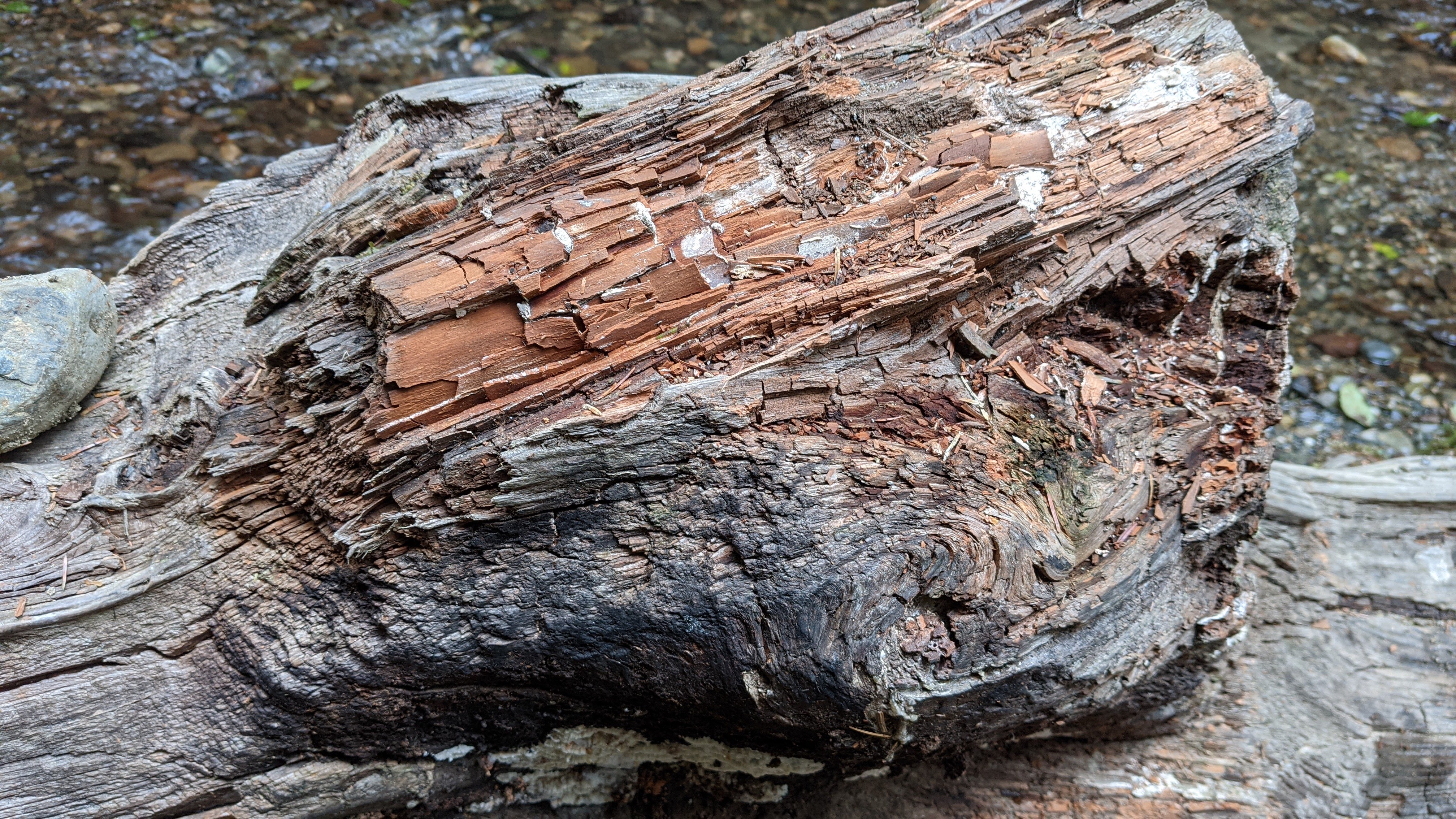
Fungi are essential to the turnover of carbon locked up in woody materials. Lignin is a component of the secondary cell wall in plants, composing much of what we call wood, and is notoriously difficult to break down. Wood decay fungi are generally divided into two major groups: white rotters that break down both lignin and cellulose and brown rotters that have lost their ability to degrade lignin (Figure \(\PageIndex{3}\)). The lignin-rich material left behind by brown rotters provides moisture retention and a springy, lightness to the soil substrate in forest ecosystems.
Mutualistic Relationships
Symbiosis (sym - shared, bio - life) is the ecological interaction between two or more organisms of different species that live together in a close physical association. The definition does not describe the quality of the interaction. When both members of the association receive a net benefit, the symbiotic relationship is called mutualistic. When one partner benefits at the expense of the other, it is parasitism. If one partner benefits but the other is unaffected, it is commensalism. Mutualistic relationships, however, are rarely so clear cut. Instead, these relationships often exist somewhere along the parastism-mutualism continuum, displaying elements of each. Fungi form these complex mutualistic associations with many types of organisms, including cyanobacteria, algae, plants, and animals.
Mycorrhizal Relationships
One of the most remarkable associations between fungi and plants is the establishment of mycorrhizae. Mycorrhiza, which comes from the Greek words myco meaning fungus and rhizo meaning root, refers to the association between vascular plant roots and their symbiotic fungi. Around 90 percent of all plant species form mycorrhizal relationships with fungi. In a mycorrhizal association, the fungal mycelia use their extensive network of hyphae and large surface area in contact with the soil to channel water and minerals from the soil into the plant. In exchange, the plant supplies the products of photosynthesis to fuel the metabolism of the fungus.
There are a number of types of mycorrhizae. Ectomycorrhizae (“outside” mycorrhiza) form when fungi envelope the roots in a sheath (called a mantle) and a Hartig net of hyphae that extends into the roots between cells (Figure \(\PageIndex{4}\) a and Figure \(\PageIndex{5}\) a). The fungal partner can belong to the Ascomycota, Basidiomycota or occasionally one of the zygospore-forming Endogonales. Ectomycorrhizal relationships tend to be present in temperate and boreal forest trees, though their importance in tropical forests is currently being elucidated. In a second type, fungi in the Glomeromycota form arbuscular mycorrhiza (called endomycorrhizae). The fungi form arbuscules, highly branched hyphal structures that penetrate root cell walls and are the site of the metabolic exchanges between the fungus and the host plant (Figure \(\PageIndex{4}\) b and Figure \(\PageIndex{5}\) b). The arbuscules (from the Latin word for little trees) have a shrub-like appearance due to increase surface area for exchange across membranes.
Orchids rely on a third type of mycorrhiza. Orchids are a group of plants, often living as epiphytes, that form tiny seeds without much storage to sustain germination and growth--the black specks in vanilla bean ice cream are the seeds of an orchid. Their seeds will not germinate without a mycorrhizal partner (usually a Basidiomycete). The orchid seed attracts a mycorrhizal fungus via chemical signals, then when the relationship is established, begins lysing the fungal cells to gain nutrients from the fungus. It is not until the orchid produces its leaves and can successfully photosynthesize that sugars begin being transferred to the fungus. Plants in the Ericaceae (heath family) represent at least two different types of mycorrhiza: Ericoid and Monotropoid.
Art Connection
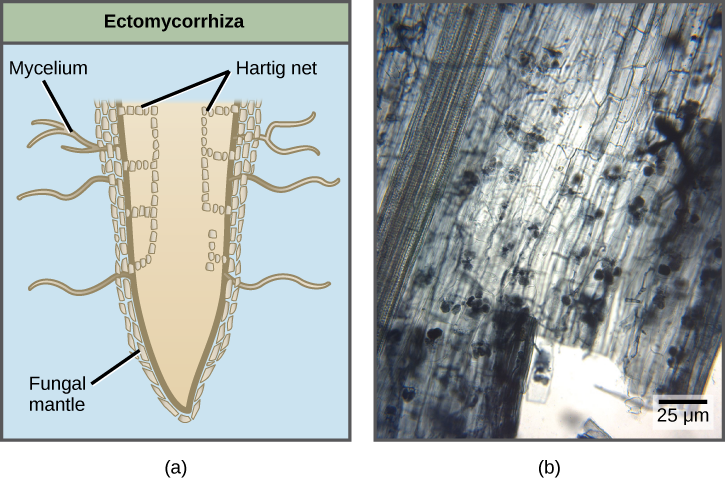

Evolution Connection
Mycorrhizae are the mutually beneficial symbiotic association between roots of vascular plants and fungi. A well-accepted theory proposes that fungi were instrumental in the evolution of the root system in plants and contributed to the success of angiosperms. The bryophytes (mosses and liverworts), which are considered the most primitive plants and the first to survive on dry land, do not have a true root system; some have vesicular–arbuscular mycorrhizae and some do not. They depend on a simple rhizoid (an underground organ) and cannot survive in dry areas. True roots appeared in vascular plants. Vascular plants that developed a system of thin extensions from the rhizoids (found in mosses) are thought to have had a selective advantage because they had a greater surface area of contact with the fungal partners than the mosses and liverworts, thus availing themselves of more nutrients in the ground.
Fossil records indicate that fungi preceded plants on dry land. The first association between fungi and photosynthetic organisms on land involved moss-like plants and endophytes. These early associations developed before roots appeared in plants. Slowly, the benefits of the endophyte and rhizoid interactions for both partners led to present-day mycorrhizae; up to about 90 percent of today’s vascular plants have associations with fungi in their rhizosphere. The fungi involved in mycorrhizae display many characteristics of primitive fungi; they produce simple spores, show little diversification, do not have a sexual reproductive cycle, and cannot live outside of a mycorrhizal association. The plants benefited from the association because mycorrhizae allowed them to move into new habitats because of increased uptake of nutrients, and this gave them a selective advantage over plants that did not establish symbiotic relationships.
Lichens
Lichens are typically defined as a symbiotic relationship between a fungal partner (the mycobiont, typically an ascomycete) and an alga or cyanobacterium (the photobiont). The mycobiont forms the thallus, wrapping a thin layer of photobiont cells in fungal tissue. The fungus therefore houses the photobiont, while the photobiont makes sugars via photosynthesis that the fungus feeds on. The fungus controls the reproduction of the photobiont and when the photobiont gets to eat. The fungus is, in essence, farming the photobiont. Would you consider this a parasitism or mutualism?
This association forms a unified thallus that appears to be a single organism, thus lichens have species names. However, the more scientists look, the more interacting organisms they seem to find in lichens. Tripartite lichens contain two photobionts: an alga and a cyanobacteria. Many lichens have been found to contain a second mycobiont (typically a basidiomycete yeast), endohyphal bacteria, and other organisms whose role in the lichen relationship we do not yet understand. See Chapter 3.7 in the Photographic Atlas for a deeper dive into lichens.

Other examples of fungus–plant mutualism include the endophytes: fungi that live inside tissue without damaging the host plant. Endophytes release toxins that repel herbivores, or confer resistance to environmental stress factors, such as infection by microorganisms, drought, or heavy metals in soil.
Fungal-Animal Mutualism
Fungi have evolved mutualisms (and parasitisms!) with numerous insects in phylum Arthropoda: jointed, legged invertebrates. Arthropods depend on the fungus for protection from predators and pathogens, while the fungus obtains nutrients and a way to disseminate spores into new environments. The association between species of Basidiomycota and scale insects is one example. The fungal mycelium covers and protects the insect colonies. The scale insects foster a flow of nutrients from the parasitized plant to the fungus. In a second example, leaf-cutting ants of Central and South America literally farm fungi. They cut disks of leaves from plants and pile them up in underground gardens (Figure \(\PageIndex{7}\)). A basidiomycete fungus (Leucoagaricus gongylophorus) is cultivated in these disk gardens from bits of mycelium from the queen's original colony, meaning the fungi within these gardens are all genetically quite similar (a monoculture, if you will). The fungus digests the cellulose in the leaves that the ants cannot break down, then produces nutrient-rich structures called gongylidia on which the ants feed. The ants patrol their garden, tending their fungi. There are actinomycetes (filamentous bacteria) that live on the surface of the ant, within its cuticle, that produce antifungal compounds specific to another parasitic fungus (an ascomycete) that often invades these fungal gardens. Both ants and fungi benefit from the association. The fungus receives a steady supply of leaves and freedom from competition, while the ants feed on the fungi they cultivate. Watch this process in action in Video \(\PageIndex{1}\).
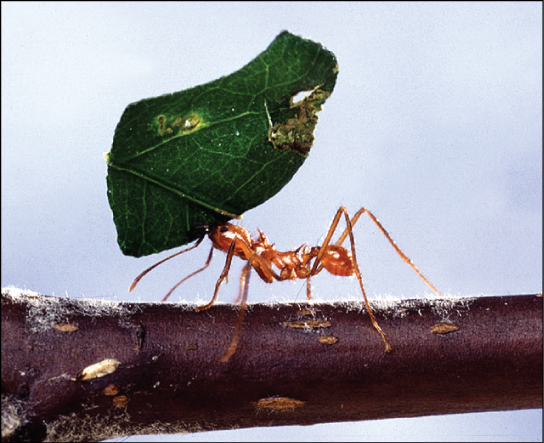
Video \(\PageIndex{1}\): Leaf cutter ants and their fungal gardens. Sourced from YouTube.
Fungivores
Animal dispersal is important for some fungi because an animal may carry spores considerable distances from the source. Fungal spores are rarely completely degraded in the gastrointestinal tract of an animal, and many are able to germinate when they are passed in the feces. Some dung fungi actually require passage through the digestive system of herbivores to complete their lifecycle. The black truffle—a prized gourmet delicacy—is the fruiting body of an underground mushroom. Almost all truffles are ectomycorrhizal, and are usually found in close association with trees. Animals eat truffles and disperse the spores. In Italy and France, truffle hunters use female pigs to sniff out truffles. Female pigs are attracted to truffles because the fungus releases a volatile compound closely related to a pheromone produced by male pigs.
Fungal Parasites of Plants
Parasitism describes a symbiotic relationship in which one member of the association benefits at the expense of the other. Both parasites and pathogens harm the host; however, the pathogen causes a disease, whereas the parasite usually does not.
The production of sufficient good-quality crops is essential to human existence. Plant diseases have ruined crops, bringing widespread famine. Many plant pathogens are fungi that cause tissue decay and eventual death of the host (Figure \(\PageIndex{8}\)). In addition to destroying plant tissue directly, some plant pathogens spoil crops by producing potent toxins. Fungi are also responsible for food spoilage and the rotting of stored crops. For example, the fungus Claviceps purpurea causes ergot, a disease of cereal crops (especially of rye). Although the fungus reduces the yield of cereals, the effects of the ergot's alkaloid toxins on humans and animals are of much greater significance. In animals, the disease is referred to as ergotism. The most common signs and symptoms are convulsions, hallucination, gangrene, and loss of milk in cattle. The active ingredient of ergot is lysergic acid, which is a precursor of the drug LSD. Smuts, rusts, and powdery or downy mildew are other examples of common fungal pathogens that affect crops.
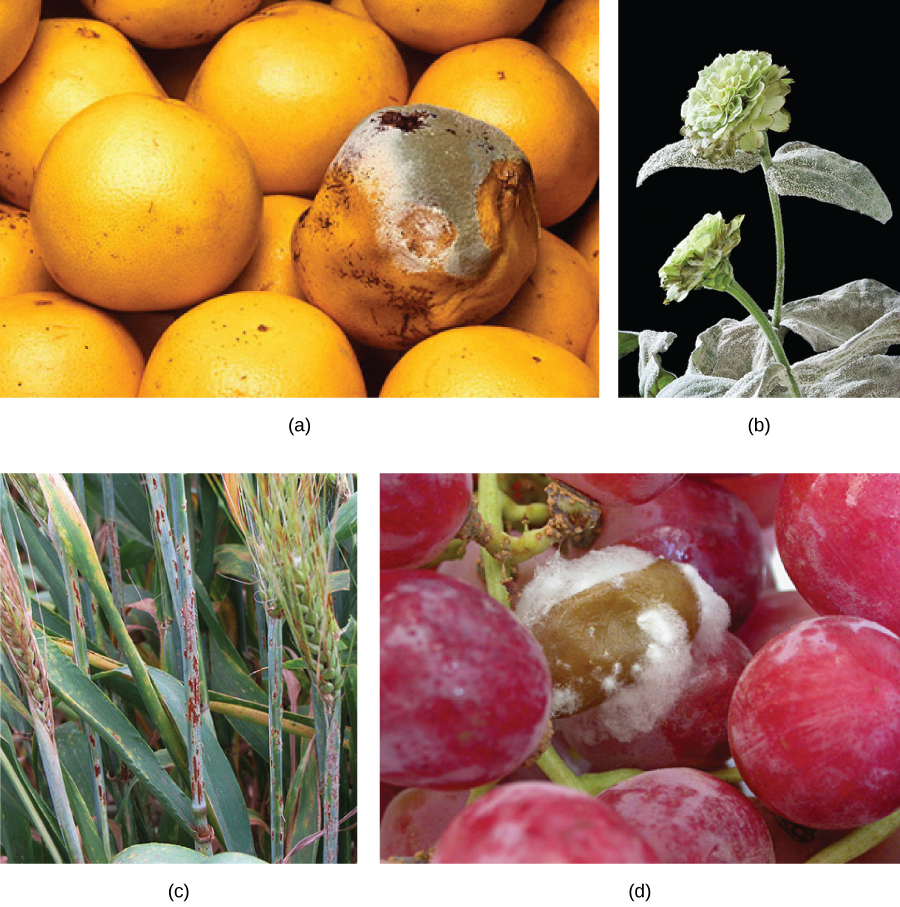
Aflatoxins are toxic, carcinogenic compounds released by fungi of the genus Aspergillus. Periodically, harvests of nuts and grains are tainted by aflatoxins, leading to massive recall of produce. This sometimes ruins producers and causes food shortages in developing countries.
Summary
Fungi occupy nearly all environments on Earth, but are frequently found in cool, moist places with a supply of decaying material. Fungi are saprotrophs that decompose organic matter, mutualists, and parasites. Many successful mutualistic relationships involve a fungus and another organism. Some groups of fungi establish complex mycorrhizal associations with the roots of plants. Approximately 90% of all plant species form some type of mycorrhizal relationship and it is likely that this symbiosis aided early plants in their transition onto land. Lichens are a symbiotic relationship between a fungus and a photosynthetic organism, usually an alga or cyanobacterium. The photosynthetic organism provides energy derived from light and carbohydrates, while the fungus supplies minerals and protection. Some animals that consume fungi help disseminate spores over long distances.
Attributions
Curated and authored by Maria Morrow, CC-BY-NC, using the following sources:
- 24.3 Ecology of Fungi and 24.4 Fungal Parasites and Pathogens from Biology 2e by OpenStax (licensed CC-BY). Access for free at openstax.org.


